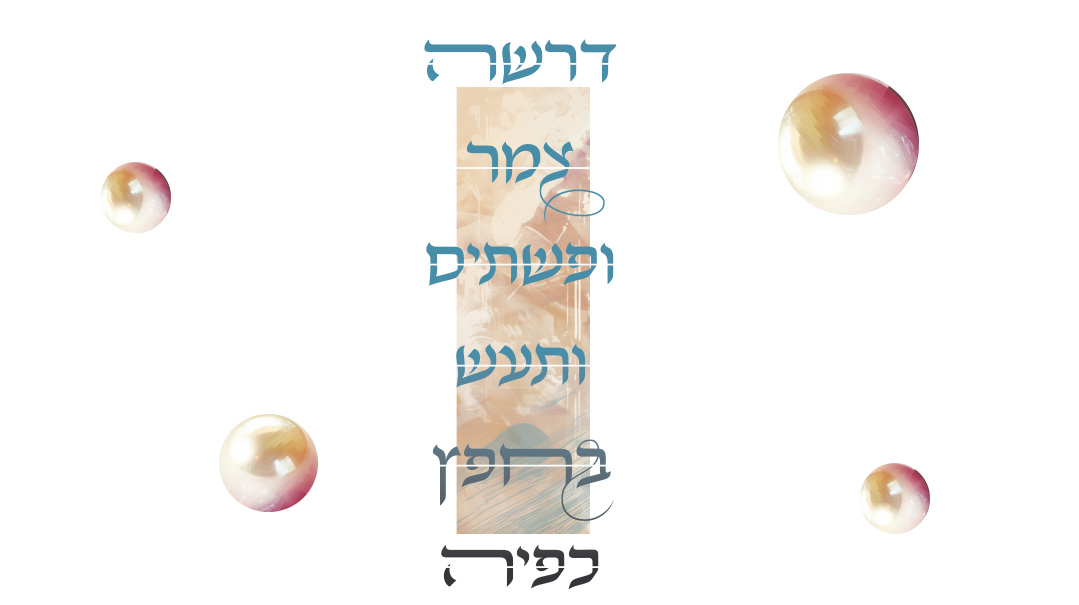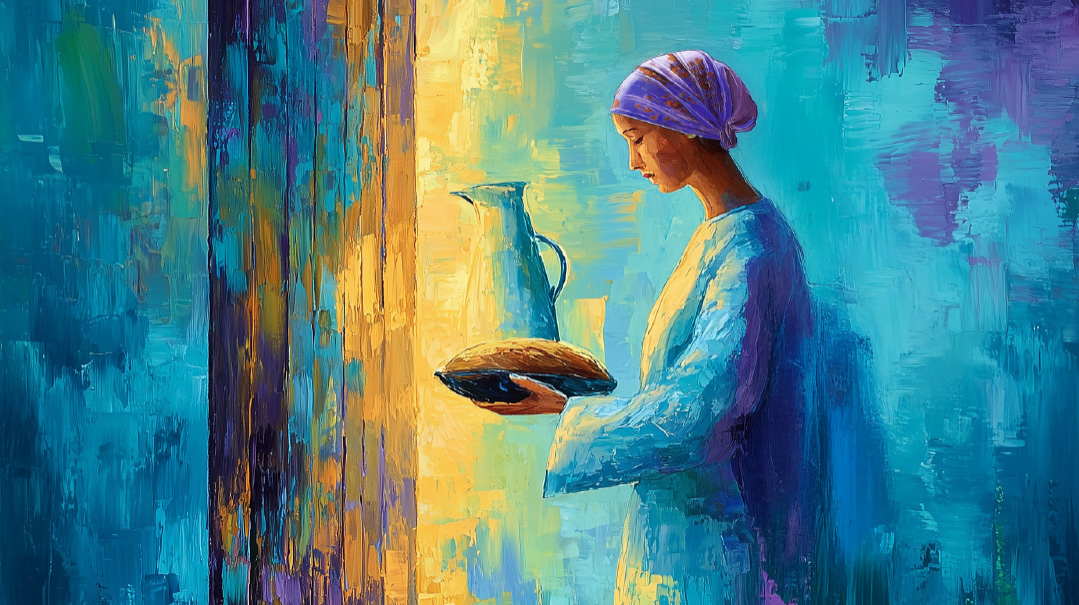Every Moment Is Precious
| August 27, 2024Darshah tzemer u’fishtim — she seeks wool and linen. Why is she out searching for fibers to spin?

Every Moment Is Precious
Mrs. Shira Hochheimer sees Shlomo Hamelech’s timeless words as a guide to improving ourselves, which will in turn improve our relationship with our spouse and our children.
Society wouldn’t function without trust. There’s a fantastic living history museum village close to our home in Rochester. It has 30 plus homes with costumed guides who reenact life before the Industrial Revolution.
In one of the homes, we’d always find the “mother” in the same spot — at the spinning wheel. Next to her was a second, smaller spinning wheel. The guide would explain that in the old days, after all the chores were done, a woman was expected to spin. Spinning is monotonous and uncreative and unending. It’s a job that was never done. And if anyone in the house had any downtime, from as young as the age of five, they were also expected to do their part.
The goal of spinning is to take fiber and turn it into thread so it can be used to create fabric.
With this background, the pasuk describing the Eishes Chayil and her spinning seems odd.
Darshah tzemer u’fishtim — she seeks wool and linen. Why is she out searching for fibers to spin? Rav Shaul Siriro explains that the Eishes Chayil wants to do the work of spinning, so she’s taking the initiative to find the wool and linen to spin rather than let her spinning wheel sit idle.
Vata’as b’chefetz kapeha — and her hands make them with desire. The Malbim says this implies that the Eishes Chayil is motivated and works with zerizus.
What drives the Eishes Chayil to do the mundane job of spinning with so much enthusiasm?
The Eishes Chayil knows two things. First, every moment of life is precious. She wants to use her time in the most productive ways possible. At the end of the day, when she can’t do anything else, she can at least spin. Second, as Chazal tell us in Kesubos 59b, it’s spiritually dangerous to sit around and do nothing. Boredom leads to sin and inactivity can make a person crazy.
This pasuk will mean something different for every woman. A 40-year-old woman with a toddler is different than a 40-year-old whose kids are all in high school. Being darshah, seeking out ways to be productive, means having a lot of self-awareness of my needs, my time constraints, and my family’s needs. I can’t feel guilty that my friend is doing more than I am, nor can I make myself so busy, I’m worn out and stressed.
The key to being darshah is to look for times in my day where I can add an activity. For a 20-year-old, this could mean dropping off food at the bikur cholim room between work and school. A young mother might get on the floor and play with her toddler while dinner is cooking. And an older mother with kids out of the house can get back to shul on Shabbos morning and visit a homebound neighbor later in the day.
My grandmother lived this ideal. Growing up, she would visit my childhood home a few times a year. I knew she was there because I would invariably hear, “Ma, sit down, relax,” but she would be at the dryer folding all the towels as the buzzer sounded. When all the laundry was folded, she’d go out to the garden to weed and plant flowers — a task that is never done. She’d travel to all of her children’s homes and leave folded laundry and beautiful gardens behind wherever she went.
There are times when we’re too tired and burnt out to be productive. We’ll need to refresh. After learning this pasuk, I shut my phone and started doing 1,000-piece puzzles with my whole family. And then when I was refreshed, I stood up, and like my grandmother, got back to work.
Question: Are there times in my day when I can add an activity that builds something?
Shira Hochheimer is the author of Eishes Chayil: Ancient Wisdom For Women of Today, a presenter for Torat Imecha Nach Yomi, and an administrator for WITS in Baltimore, MD.
Garments of the Soul
Mrs. Debbie Greenblatt shows us what we can learn about a Jewish womanÕs tremendous capabilities from Shlomo Hamelech’s descriptions of the Eishes Chayil, whatever stage of life she’s at.
Improving our middos and cultivating our emunah are an integral part of our journey as Jewish women. The inspiration we encounter along the way, whether in the form of people we meet, a shiur we hear, or a moment of clarity in which we sense Hashem in our life gives us that boost we need to keep going.
How can we hold on to those moments of inspiration and turn them into an acquisition that actually changes us? What about the middos tovos we aspire to? How do we make them more than words and nice ideas? In short: Is there a way to concretize inspiration?
The Malbim on our pasuk gives us a unique viewpoint. Our middos are called, in the parlance of Chazal, levushim, the garments of our souls. It’s what our nefesh “wears” and how we appear in the world. No sooner do you exchange pleasantries with someone you just met, then their middos become apparent. Get to know them a little more, and their emunah starts to show.
What the Malbim teaches us is that these garments of our souls become established and strengthened through the actions we take. When we habituate ourselves to do mitzvos and maasim tovim, we root the good middos in our nefesh, and then we’re constantly clothed by them. The Eishes Chayil seeks out wool and linen, symbolizing good deeds, in order to weave out of them the clothing her soul will wear in This World.
The Alshich explains that each part of the body is connected to a mitzvah and that extending a hand represents the mitzvah of tzedakah. Wool and linen are each spun into cloth differently, each one utilizing a different part of the hand. She uses her hands (kapeha), her different abilities, to extend herself in the mitzvah of tzedakah, to the point that it seems as if her hands themselves desire to do this mitzvah of their own accord.
When we understand that inspiration isn’t enough, that we have to take action to keep a lasting impression on our neshamah, we, too, will be like the Eishes Chayil who is “darshah tzemer u’fishtim,” who seeks out good deeds.
Debbie Greenblatt is a senior lecturer for the Gateways organization and a teacher of both the observant and the not-yet-observant. She is also director of education at Core.
Against Her Nature
Mrs. Shira Smiles connects the pesukim of Eishes Chayil to the women in Tanach.
The Midrash ascribes this pasuk to Leah Imeinu, who greeted Yaakov Avinu with a beautiful countenance after she exchanged the mandrakes she had for his company and was thus worthy to conceive the tribe of Yissachar.
In Ruach Eliyahu, Rav Elya Svei ztz”l notes that going out to greet her husband was an act of supreme abasement for Leah Imeinu. Consequently, she was rewarded with Yissachar, who was the tribe of great Torah scholars.
Rav Svei further points out that in Yaakov’s brachah to Yissachar he is called a “chamor garem — a strong-boned donkey.” (Bereishis 49:13) “Chamor garem” can also be understood as “Yissachar was caused by a donkey.” According to the midrash, the donkey’s braying alerted Leah that Yaakov Avinu had returned and she went out to greet him.
Why is this an important detail to include in the blessing? And why is Yissachar compared to a donkey, if a horse is a much stronger animal?
A donkey is unpretentious and prepared to sleep in any physical condition, and carries a heavy load without complaining or kicking its master. These are the qualities necessary if one wants to completely dedicate his life to Torah; simplicity, modesty, and humility. Yaakov Avinu is highlighting these special characteristics that Yissachar inherited from his mother, who unassumingly acted counter to her nature to seize spiritual greatness.
The Eishes Chayil is described here as one who works with “wool and linen,” which brings to mind shaatnez, a forbidden combination of fibers. In Peninei Da’as, Rav Elya Meir Bloch ztz”l observes that we find multiple dimensions and layers woven into Leah Imeinu’s character. The Midrash teaches that Hashem saw her true intention deep within her heart, her sole desire to expand Klal Yisrael by establishing another tribe. At the same time, when her daughter, Dina, is described as “going out to look about among the daughters of the land” (Bereishis 34:1), we find Chazal’s acute censure: “Like mother, like daughter.” Their tendency to “step out” is viewed in a negative light. Although Leah Imeinu’s motive was l’Sheim Shamayim, her act of going out to greet her husband transmitted an inappropriate aspect to her daughter. How careful we must be, cautions Rav Bloch, even when involved in a mitzvah, not to compromise our tzniyus in any way.
Leah Imeinu represents the Eishes Chayil, who is prepared to dedicate herself entirely to Torah. She also directs us to be honest about our motives and keep our tzniyus a priority.
Rebbetzin Shira Smiles is a lecturer in the Yerushalayim area, and a mechaneches in Darchei Binah Seminary. She is the author of five books, Torah Tapestries, which include extensive essays on each parshah.
(Originally featured in Family First, Issue 908)
Oops! We could not locate your form.







